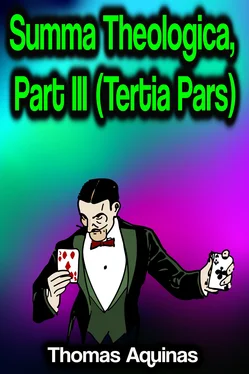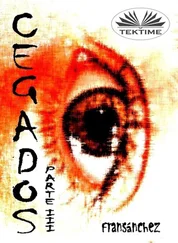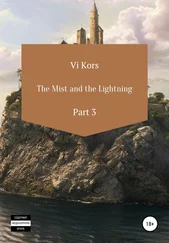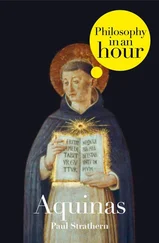Reply Obj. 1: As stated above (Q. 19, A. 3), Christ did not merit the glory of the soul, in respect of which He is said to have been a comprehensor, but the glory of the body, to which He came through His Passion.
Wherefore the reply to the Second Objection is clear.
Reply Obj. 3: Since Christ was both God and man, He had, even in His humanity, something more than other creatures—namely, that He was in the state of beatitude from the very beginning.
Question 35. Of Christ's Nativity (In Eight Articles)
After considering Christ's conception, we must treat of His nativity. First, as to the nativity itself; secondly, as to His manifestation after birth.
Concerning the first there are eight points of inquiry:
(1) Whether nativity regards the nature or the person?
(2) Whether another, besides His eternal, birth should be attributed to Christ?
(3) Whether the Blessed Virgin is His Mother in respect of His temporal birth?
(4) Whether she ought to be called the Mother of God?
(5) Whether Christ is the Son of God the Father and of the Virgin Mother in respect of two filiations?
(6) Of the mode of the Nativity;
(7) Of its place;
(8) Of the time of the Nativity. _______________________
FIRST ARTICLE [III, Q. 35, Art. 1]
Whether Nativity Regards the Nature Rather Than the Person?
Objection 1: It would seem that nativity regards the nature rather than the person. For Augustine [*Fulgentius] says (De Fide ad Petrum): "The eternal Divine Nature could not be conceived and born of human nature, except in a true human nature." Consequently it becomes the Divine Nature to be conceived and born by reason of the human nature. Much more, therefore, does it regard human nature itself.
Obj. 2: Further, according to the Philosopher (Metaph. v), "nature" is so denominated from "nativity." But things are denominated from one another by reason of some likeness. Therefore it seems that nativity regards the nature rather than the person.
Obj. 3: Further, properly speaking, that is born which begins to exist by nativity. But Christ's Person did not begin to exist by His nativity, whereas His human nature did. Therefore it seems that the nativity properly regards the nature, and not the person.
On the contrary, Damascene says (De Fide Orth. iii): "Nativity regards the hypostasis, not the nature."
I answer that, Nativity can be attributed to someone in two ways: first, as to its subject; secondly, as to its terminus. To him that is born it is attributed as to its subject: and this, properly speaking, is the hypostasis, not the nature. For since to be born is to be generated; as a thing is generated in order for it to be, so is a thing born in order for it to be. Now, to be, properly speaking, belongs to that which subsists; since a form that does not subsist is said to be only inasmuch as by it something is: and whereas person or hypostasis designates something as subsisting, nature designates form, whereby something subsists. Consequently, nativity is attributed to the person or hypostasis as to the proper subject of being born, but not to the nature.
But to the nature nativity is attributed as to its terminus. For the terminus of generation and of every nativity is the form. Now, nature designates something as a form: wherefore nativity is said to be "the road to nature," as the Philosopher states (Phys. ii): for the purpose of nature is terminated in the form or nature of the species.
Reply Obj. 1: On account of the identity of nature and hypostasis in God, nature is sometimes put instead of person or hypostasis. And in this sense Augustine says that the Divine Nature was conceived and born, inasmuch as the Person of the Son was conceived and born in the human nature.
Reply Obj. 2: No movement or change is denominated from the subject moved, but from the terminus of the movement, whence the subject has its species. For this reason nativity is not denominated from the person born, but from nature, which is the terminus of nativity.
Reply Obj. 3: Nature, properly speaking, does not begin to exist: rather is it the person that begins to exist in some nature. Because, as stated above, nature designates that by which something is; whereas person designates something as having subsistent being. _______________________
SECOND ARTICLE [III, Q. 35, Art. 2]
Whether a Temporal Nativity Should Be Attributed to Christ?
Objection 1: It would seem that temporal nativity is not to be attributed to Christ. For "to be born is a certain movement of a thing that did not exist before it was born, which movement procures for it the benefit of existence" [*Cf. Augustine, De Unit. Trin. xii]. But Christ was from all eternity. Therefore He could not be born in time.
Obj. 2: Further, what is perfect in itself needs not to be born. But the Person of the Son of God was perfect from eternity. Therefore He needs not to be born in time. Therefore it seems that He had no temporal birth.
Obj. 3: Further, properly speaking, nativity regards the person. But in Christ there is only one person. Therefore in Christ there is but one nativity.
Obj. 4: Further, what is born by two nativities is born twice. But this proposition is false; "Christ was born twice": because the nativity whereby He was born of the Father suffers no interruption; since it is eternal. Whereas interruption is required to warrant the use of the adverb "twice": for a man is said to run twice whose running is interrupted. Therefore it seems that we should not admit a double nativity in Christ.
On the contrary, Damascene says (De Fide Orth. iii): "We confess two nativities in Christ: one of the Father—eternal; and one which occurred in these latter times for our sake."
I answer that, As stated above (A. 1), nature is compared to nativity, as the terminus to movement or change. Now, movement is diversified according to the diversity of its termini, as the Philosopher shows (Phys. v). But, in Christ there is a twofold nature: one which He received of the Father from eternity, the other which He received from His Mother in time. Therefore we must needs attribute to Christ a twofold nativity: one by which He was born of the Father from all eternity; one by which He was born of His Mother in time.
Reply Obj. 1: This was the argument of a certain heretic, Felician, and is solved thus by Augustine (Contra Felic. xii). "Let us suppose," says he, "as many maintain, that in the world there is a universal soul, which, by its ineffable movement, so gives life to all seed, that it is not compounded with things begotten, but bestows life that they may be begotten. Without doubt, when this soul reaches the womb, being intent on fashioning the passible matter to its own purpose, it unites itself to the personality thereof, though manifestly it is not of the same substance; and thus of the active soul and passive matter, one man is made out of two substances. And so we confess that the soul is born from out the womb; but not as though, before birth, it was nothing at all in itself. Thus, then, but in a way much more sublime, the Son of God was born as man, just as the soul is held to be born together with the body: not as though they both made one substance, but that from both, one person results. Yet we do not say that the Son of God began thus to exist: lest it be thought that His Divinity is temporal. Nor do we acknowledge the flesh of the Son of God to have been from eternity: lest it be thought that He took, not a true human body, but some resemblance thereof."
Reply Obj. 2: This was an argument of Nestorius, and it is thus solved by Cyril in an epistle [*Cf. Acta Concil. Ephes., p. 1, cap. viii]: "We do not say that the Son of God had need, for His own sake, of a second nativity, after that which is from the Father: for it is foolish and a mark of ignorance to say that He who is from all eternity, and co-eternal with the Father, needs to begin again to exist. But because for us and for our salvation, uniting the human nature to His Person, He became the child of a woman, for this reason do we say that He was born in the flesh."
Читать дальше












